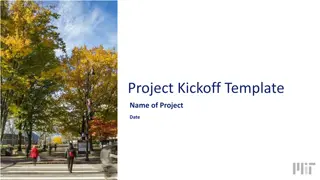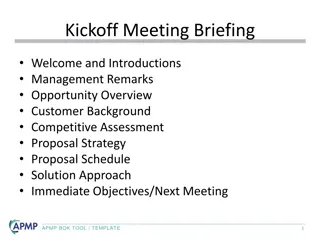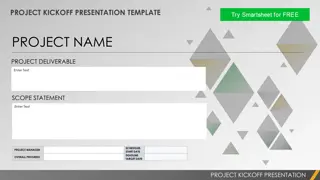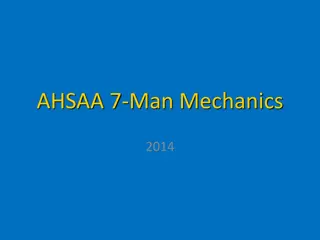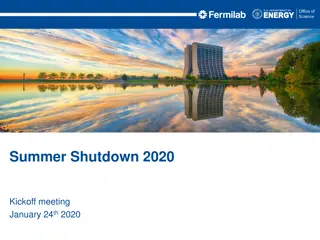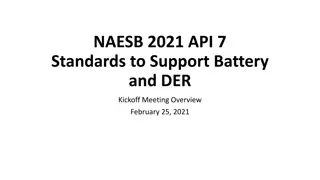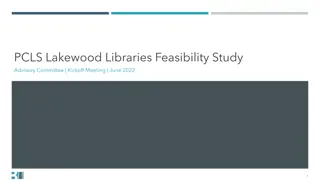
Understanding ETSS Model for Storm Surge Prediction
Discover the Extra-Tropical Storm Surge (ETSS) Model, a modification of the SLOSH model utilizing GFS winds for predicting storm surge in large extra-tropical storms. Learn about SHEF, a hydrometeorological format for data sharing, and the purpose of implementing this model. Explore why this project is crucial for providing system-friendly predictions at the coastal interface during storm events, enhancing flood severity assessments.
Uploaded on | 2 Views
Download Presentation

Please find below an Image/Link to download the presentation.
The content on the website is provided AS IS for your information and personal use only. It may not be sold, licensed, or shared on other websites without obtaining consent from the author. If you encounter any issues during the download, it is possible that the publisher has removed the file from their server.
You are allowed to download the files provided on this website for personal or commercial use, subject to the condition that they are used lawfully. All files are the property of their respective owners.
The content on the website is provided AS IS for your information and personal use only. It may not be sold, licensed, or shared on other websites without obtaining consent from the author.
E N D
Presentation Transcript
Extra-Tropical Storm Surge (ETSS) Model and Post Processing V 2.0 Pre-Implementation Briefing December, 2014 Huiqing Liu, Ryan Schuster, and Arthur Taylor MDL/NWS/NOAA 1
Outline Project Description What is ETSS?, What is SHEF?, Why are we doing this? Quad Chart Scope and benefits ETSS 2.0 Flow Chart Testing Resources Dissemination Repository Architecture 2
What is ETSS? The Extra Tropical Storm Surge Model is a modification of the SLOSH model which uses GFS winds to predict storm surge based on large extra-tropical storms Produces Coastal Guidance 4 times a day (00z, 06z, 12z and 18z) when the GFS winds are available (roughly 4 hours 50 min after nominal forecast time) On NDFD CONUS Grid (merges 3 extra-tropical basins) On NDFD Alaska Grid (merges 3 extra-tropical basins) 3
What is SHEF? Standard Hydrometeorological Exchange Format Designed for data sharing and readability - Identifies location, data type, time and interval of measurements, units Example: ****0000021076****CBOFS KWBC 061842 TIDNT :SHEF ENCODED 30 MINUTE WATER LEVEL FORECAST GUIDANCE :WATER LEVEL VALUES REFERENCED TO MLLW IN FEET (HMIFZ) :TIME ZONE IS UTC :WATER LEVEL FORECAST GUIDANCE IS FOR TOTAL WATER LEVELS :PROVIDED BY DOC/NOAA/NOS/CO-OPS :corms@noaa.gov 301-713-2540 .E SWPV2 20120906 Z DH1200/HMIFZ/DIN30/ 0.427 / 0.887 / 1.122 / 1.435 / 1.646 / 1.865 .E1 2.065/ 2.219 / 2.446 / 2.589 / 2.676 / 2.767 / 2.665 / 2.500 / 2.322 / 2.156 / 1.939 / 1.764 .E2 1.602/ 1.407 / 1.251 / 1.057 / 0.925 / 0.789 / 0.781 / 0.880 / 1.045 / 1.230 / 1.414 / 1.616 .E3 1.820/ 2.007 / 2.182 / 2.363 / 2.453 / 2.538 / 2.498 / 2.405 / 2.288 / 2.128 / 1.994 / 1.820 .E4 1.631/ 1.385 / 1.184 / 1.027 / 0.931 / 0.897 / 0.943 / 1.046 / 1.175 / 1.347 / 1.563 / 1.812 .E5 2.087/ 2.375 / 2.632 / 2.855 / 3.002 / 3.111 / 3.150 / 3.104 / 3.001 / 2.853 / 2.699 / 2.524 .E6 2.322/ 2.086 / 1.812 / 1.537 / 1.313 / 1.164 / 1.073 / 1.065 / 1.116 / 1.191 / 1.267 / 1.352 .E7 1.464/ 1.598 / 1.754 / 1.916 / 2.050 / 2.139 / 2.167 / 2.138 / 2.071 / 1.972 / 1.848 / 1.715 .E8 1.573/ 1.419 / 1.239 / 1.042 / 0.866 / 0.724 / 0.648 4
Why are We Doing This? Depending on the storm event, in the upper reaches of some tidal rivers, flooding from storm surge may be followed by river flooding from rain in the upland watershed. This increases the flood severity. NOAAWatch.gov River forecast centers (RFCs) use AHPS and lack system-friendly predictions at the coastal interface (i.e. river mouths) Bias-corrected SHEF output from ETSS would provide that guidance in an AHPS-readable format Data also available on AWIPS for WFOs 5
Extra Tropical Storm Surge V2.0 Project Status as of 11/3/2014 Y R G Scheduling Project Information and Highlights R G Milestone (NCEP) Date Status Initial coordination with SPA team 12/16/2014 Lead: Huiqing Liu, Ryan Schuster, Arthur Taylor, MDL and Becky Cosgrove, NCO MDL testing complete 1/16/2015 Scope: 1. Nesting coarse extra-tropical grid and existing fine scale tropical basins for East Coast and Gulf of Mexico This Implementation will add over land calculations Will also add tidal forcing. Operationalize ETSS post processing by porting the code the computes total water level guidance to an NCO approved programming language Provide NCO with code to SHEF encode the total water level guidance Final Code Delivered to NCO 1/16/2015 2. 3. 4. Technical Information Notice Issued 2/1/2015 SPA begins prep work for 30 day test 1/19/2015 30-day evaluation begins 2/16/2015 5. 30-day evaluation ends 3/17/2015 Expected Benefits: 1. Computes inundation based on (a) surge, and (b) latest overland grids from the tropical program. 2. Provide RFC s via AHPS surge plus tide bias corrected guidance 3. Make post processing of extra tropical storm surge more robust IT testing ends 2/13/2015 Management Briefing 3/27/2015 Operational Implementation 3/31/2015 G G Issues/Risks Finances Issues: -- Adding point data to SBN (needs headers) -- Determine which variables / stations to SHEF encode Associated Costs: Federal FTE labor and Contract Support Funding Sources: MDL Base and Sandy Supplemental Risks: -- Headers are not available -- Don t determine the right variables / stations Computational Resources: 1. Currently 2 CPU for 5 minutes 2. Will use 6 CPU for 35 minutes (Model) + 3 CPU for 8 minutes (Post Processing). Mitigation: -- Coordinate with data management / TOC -- Coordinate with AHIPS / RFC contacts 6 6 R Y G 6 Management Attention Required Potential Management Attention Needed On Track v1.0 09/14//07 6
Project Scope and Benefits Scope: Nest coarse and fine scale model basins Introduce overland flooding calculations Produce SHEF-encoded bias-corrected total water level guidance at coastal stations Provide SHEF messages to river forecast centers (RFCs) Benefits: Computes inundation based on surge, and latest overland grids from the tropical program. ETSS post-processing becomes more robust and reliable RFCs receive hourly guidance within their forecast system 7
ETSS 2.0 running at 00z, 06z, 12z and 18z Kick off Cron Job at 04:50z, 10:50z, 16:40z ,22:40z , for GFS output data time delay Kick off setup.sh and check.sh to copy GFS data needed by ETSS. Also kick off jgfs_stormsurge.ecf runETSS.sh Prepare to define GFS data source and Model working directory Kick off script exgfs_stormsurge_sh.ecf Submit job JGFS_STORMSURGE Prepare GFS data and run mdl_c10_gen mdl_cy_puv10 Output Data and kick off post- processing Run gfs_stormsurge*poe.sh run ETSS2.0 mdl_mdlsurge mdl_gridmerge Pre processing GFS wind data mdl_c10_gen extract past forcing fields mdl_cy_puv10 extract current and forecast forcing fields Stations output files are in text format whole grid output files are in GRIB-2 format Assign 6 cpu to first run ETSS 2.0 model in 6 extra tropical basins and then assign 6 cpu to run in tropical basins Post processing output data mdl_mdlsurge handle stations output mdl_gridmerge handle whole grid output 8
Post.ETSurge2.0 running for 00z, 06z, 12z and 18z runMe.sh defines working directory and calls kickoff job JETSURGE_KICKOFF sets up env vars and starts exetsurge_kickoff.sh. ecf Kicked off after ETSS2.0 model run exetsurge_kickoff.sh.ecf gets surge and BUFR obs data, kicks off ECFs: jetsurge_griddat.ecf waits for JETSURGE_PARSEDAT then runs JETSURGE_GRIDDAT jetsurge_combdat.ecf waits for JETSURGE_GRIDDAT then runs JETSURGE_COMBDAT jetsurge_parsedat.ecf runs JETSURGE_PARSEDAT Runs Runs Runs exetsurge_combdat.sh.ecf to calculate anomaly, compute bias-corrected total water level and SHEF-encode the result exetsurge_parsedat.sh .ecf to debufr obs exetsurge_griddat.sh.e cf to predict tide and grid surge, tide, and obs Output SHEF 9
Testing Model Ran from Oct. 24, 2014 to now Compared to ETSS1.5: http://nws.weather.gov/mdl/surge/comparison/comp1/ Post - Processing SHEF-encoded output successfully tested using AHPS system to decode AHPS contact: Mark Armstrong (mark.armstrong@noaa.gov) Ran on WCOSS Dev machine for several weeks with correct output and format Compared to ETSS1.5 text product and plots: http://www.nws.noaa.gov/mdl/etsurge Eval Team (Proposed) NCO, MDL, OPC, NHC/TAFB, WFOs coordinated via OCWWS AHPS contact could test SHEF-output for 30-day period 10
Resources CPU Model: 6 CPU for 35 minutes Post-Processing: 3 CPU for 8 minutes Output files: Model: 55 MB CONUS grids and 125 MB ALASKA grids 4x per day (720 MB per day total) ASCII SHEF bulletins: 226KB , 4x per day (904 KB per day total) CSVs for site are 34MB (put tar.gz size instead) 11
Dissemination Model output into /com and /pcom NWS FTP: http://weather.noaa.gov/pub/SL.us008001/DF.anf/DC.etss/ SHEF-encoded output: WMO headers CONUS: SRUS70 KWNO Alaska: SRAK70 KWNO AWIPS IDs East coast: TIDTWE, Gulf of Mexico: TIDTWG, West Coast: TIDTWP, Gulf of Alaska: TIDTWC, Bering Sea: TIDTWB, Arctic Alaska: TIDTWA DBNet Alert Dbn_alert: YYYY-mm-ddTHH:MM:SS MDLFCST ETSSBULL ${job} ${pcom}/${our_dir}/etss.tCCz.bull_tar 12
Repository SVNs: https://vlab.ncep.noaa.gov/svn/etss/gfs_stormsurge/trunk https://vlab.ncep.noaa.gov/svn/etss/post.etsurge2.0/trunk Project Pages: https://vlab.ncep.noaa.gov/redmine/projects/etss/repository/show/gfs _stormsurge https://vlab.ncep.noaa.gov/redmine/projects/etss/repository/show/po st.etsurge2.0 13
Architecture ETSS1.5 Data Source: /com/gfs/prod/gfs.${PDY} Data Destination: ${MDLTEST_DIR}/com/gfs/prod/gfs.${PDY} Model Working Directory: ${MDLTEST_DIR}/tmp MDLTEST_DIR: ~/etss1.5/work Step 0: runETSS.sh YYYYMMDD XX a) Copy GFS input data from /com to ${MDLTEST_DIR}/com b) Copy ETSS 1.0 output data from /pcom to ${MDLTEST_DIR}/pcom c) Call myEcf/jgfs_stormsurge.ecf to call jobs/JGFS_STORMSURGE via bsub Step 1: jobs/JGFS_STORMSURGE a) Set environment variables and call mpirun.lsf scripts/exgfs_stormsurge.sh.ecf Step 2: scripts/exgfs_stormsurge.sh.ecf prepare GFS data step a) Prepare GRIB-2 0.5 degree resolution data before running extraction programs b) Run mdl_c10_gen to extract past (60 hours)surface pressure, and wind vector fields from GRIB-2 0.5 degree data for 6 extra-tropical basins c) Run mdl_cy_puv10 to extract current and forecast(96 hours) surface pressure, and wind vector fields from GRIB-2 0.5 degree data for 6 extra-tropical basins 15
Architecture ETSS2.0 Data Source: /com/gfs/prod/gfs.${PDY} Data Destination: ${MDLTEST_DIR}/com/gfs/prod/gfs.${PDY} Model Working Directory: ${MDLTEST_DIR}/tmp MDLTEST_DIR: ~/etss2.0/dev/work Step 0: dev/runETSS.sh YYYYMMDD XX a) Copy GFS input data from /com to ${MDLTEST_DIR}/com b) Copy ETSS 1.5 output data from /pcom to ${MDLTEST_DIR}/pcom c) Call dev/myEcf/jgfs_stormsurge.ecf to call jobs/JGFS_STORMSURGE via bsub d) Call ../../Postetss2.0/dev/runMe.sh to kickoff post etss2.0 run Step 1: jobs/JGFS_STORMSURGE a) Set environment variables and call mpirun.lsf scripts/exgfs_stormsurge.sh.ecf Step 2: scripts/exgfs_stormsurge.sh.ecf prepare GFS data step a) Prepare GRIB-2 0.5 degree resolution data before running extraction programs b) Run mdl_c10_gen to extract past (60 hours)surface pressure, and wind vector fields from GRIB-2 0.5 degree data for 6 extra-tropical basins and 29 tropical basins c) Run mdl_cy_puv10 to extract current and forecast(96 hours) surface pressure, and wind vector fields from GRIB-2 0.5 degree data for 6 extra-tropical basins and 29 tropical basins 16
Architecture ETSS1.5 Step 3: scripts/exgfs_stormsurge.sh.ecf run ETSS1.5 model step a) Call ush/gfs_stormsurge_poe.sh assign 1 CPU to run extra-tropical storm surge model in Gulf of Mexico basin and the other 1 CPU to run in other 5 basins. *) Bi-linear interpolate Atmospheric forcing fields (surface pressure, and U and V wind vector fields) from GFS 0.5 degree grids to SLOSH extra-tropical basin grids *) Generate surge archive files: 1)sshistory.${cyc}${bsn} (station output) 2)ssgrid.${cyc}${bsn} (whole domain) 17
Architecture ETSS2.0 Step 3: scripts/exgfs_stormsurge.sh.ecf run ETSS2.0 model step a) Call ush/gfs_stormsurge_poe.sh assign 6 CPU to run extra-tropical storm surge model in 6 extra-tropical basins and then call ush/gfs_stormsurge_nest_poe.sh assign 6 CPU to run extra-tropical storm surge in 29 tropical basins using nesting boundary outputted from the previous runs in extra-tropical basins. *) Bi-linear interpolate Atmospheric forcing fields (surface pressure, and U and V wind vector fields) from GFS 0.5 degree grids to SLOSH extra-tropical and tropical basin grids *) Generate surge archive files: 1)sshistory.${cyc}${bsn} (station output) 2)ssgrid.${cyc}${bsn} (whole domain) 18
Architecture ETSS1.5 Step 4: scripts/exgfs_stormsurge.sh.ecf post processing output data step a) Run program mdl_mdlsurge to extract storm surge output at stations sshistory.${cyc}${bsn} to AFOS format output mdlsurge.${cyc}{bsn} b) Run program mdl_gridmerge and mdl_gridmerge_2.5km to merge grids => 3 Alaska area basins (ssgrid.${cyc}a,ssgrid.${cyc}z and ssgrid.${cyc}k) are merged to GRIB-2 NDFD Alaska grids: 6 km NDFD Alaska grids mdlsurgegrid.${cyc}ala (mdl_gridmerge) 3 km NDFD Alaska grids mdlsurgegrid.3km.${cyc}ala (mdl_gridmerge_2.5km) * need mask files: parm/mask_alaska_6km.bin (6 km resolution) parm/mdl_etalaska.bin (3 km resolution) => 3 CONUS area basins (ssgrid.${cyc}e,ssgrid.${cyc}g and ssgrid.${cyc}w) are merged to GRIB-2 NDFD CONUS grids: 5 km NDFD CONUS grids mdlsurgegrid.${cyc}con (mdl_gridmerge) 2.5 km NDFD CONUS grids mdlsurgegrid.2.5km.${cyc}con (mdl_gridmerge_2.5km) * need mask files: parm/mask_conus_5km.bin (5 km resolution) parm/mdl_etconus.bin (2.5 km resolution) c) Run program tocgrib2super to add WMO super and individual headers to GRIB-2 files * mdlsurgegrid.*${cyc}${area}===>grib2.mdlsurgegrid.*${cyc}${area} 19
Architecture ETSS2.0 Step 4: scripts/exgfs_stormsurge.sh.ecf post processing output data step a) Run program mdl_mdlsurge to extract storm surge output at stations sshistory.${cyc}${bsn}to AFOS format output mdlsurge.${cyc}{bsn},in which mdlsurge.${cyc}e and mdlsurge.${cyc}g use results from 2 extra-tropical basins and 29 tropical basins b) Run program mdl_gridmerge to merge grids => 3 Alaska area basins (ssgrid.${cyc}a,ssgrid.${cyc}z and ssgrid.${cyc}k) are merged to GRIB-2 NDFD Alaska grids: 3 km NDFD Alaska grids mdlsurgegrid.3km.${cyc}ala (mdl_gridmerge_2.5km) * need mask files: parm/mdl_etalaska.bin (3 km resolution) => 3 extra-tropical and 29 tropical CONUS area basins (ssgrid.${cyc}${bsn}) are merged to GRIB-2 NDFD CONUS grids: 2.5 km NDFD CONUS grids mdlsurgegrid.2.5km.${cyc}con (mdl_gridmerge_2.5km) * need mask files: parm/mdl_etconus_etss2.bin (2.5 km resolution) c) Run program tocgrib2super to add WMO super and individual headers to GRIB-2 files * mdlsurgegrid.*${cyc}${area}===>grib2.mdlsurgegrid.*${cyc}${area} 20
Architecture Post.ETSurge2.0 Data Source: /com/gfs/prod/gfs.${PDY} Data Destination: ${MDLTEST_DIR}/com/gfs/prod/gfs.${PDY} Post-processing Working Directory (${DATA}): ./dev/tmp/data/tmpnwprod1/etsurge2_test.${pid} Step 0: runMe.sh a) Set up root and working directory environment variables b) Call jobs/JETSURGE_KICKOFF Step 1: jobs/JETSURGE_KICKOFF a) Set more environment variables and call scripts/exetsurge_kickoff.sh b) exetsurge_kickoff.sh copies ETSS text output and COOPS water level obs in BUFR format from data tanks; stores in ${DATA} c) Calls the three scripts in dev/tmp/myEcf: jetsurge_parsedat.sh.ecf, jetsurge_griddat.sh.ecf, jetsurge_combdat.sh.ecf Step 2: parsedat a) dev/tmp/myEcf/jetsurge_parsedat.sh.ecf uses bsub to kick off jobs/JETSURGE_PARSEDAT b) jobs/JETSURGE_PARSEDAT sets up some environmental vars and calls scripts/ exetsurge_parsedat.sh c) scripts/exetsurge_parsedat.sh creates a poescript in ${DATA} to parse BUFR files (poescript_obsraw). Mpirun.lsf then runs the BUFR-parsing scripts in parallel 21
Architecture Post.ETSurge2.0 Step 3: griddat a) dev/myEcf/jetsurge_griddat.sh.ecf waits for myEcf/jetsurge_parsedat.sh.ecf to finish parsing raw BUFR files then calls jobs/JETSURGE_GRIDDAT b) jobs/JETSURGE_GRIDDAT sets up some environmental variables and then calls scripts/exetsurge_griddat.sh to create poescript_grid in ${DATA}, which is then run using mpirun.lsf c) poescript_grid is a list of three commands: - obsAll: Grids parsed BUFR obs data - surgeAll: Parses surge text product into gridded surge data - tideAll: Calculates tides and grids them Step 4: combdat a) myEcf/jetsurge_combdat.sh.ecf waits for myEcf/jetsurge_griddat.sh.ecf to finish and then calls jobs/JETSURGE_COMBDAT b) jobs/JETSURGE_COMBDAT sets up some environmental variables and calls scripts/exetsurge_combdat.sh c) scripts/exetsurge_combdat.sh simply calls the exec/combAll to calculate anomaly and total water level from the gridded obs, surge, and tide, and turn the results into output SHEF encoded messages for each location. 22





